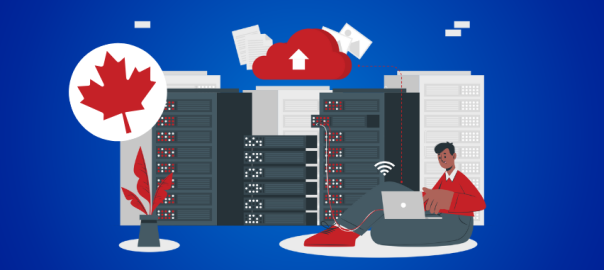Do you know where your website, emails, and files are hosted? If they’re outside Canada, your data could be at risk. And with the skyrocketing U.S. dollar, you might also be paying more for services by not choosing a Canadian provider.
Now more than ever, it’s time to take control and bring your data home to Canada. Protect your privacy, save money, and support Canadian innovation and the economy.
And let’s clear this up: Canada isn’t the 51st state (despite what you might read online). We have our own laws, priorities, and values. And when it comes to protecting your data, Canada stands tall with some of the world’s strictest privacy regulations.
If you’re not sure where your data’s hosted, now’s the time to check and act. Don’t risk your business or your privacy. You’ve worked hard for your success. Keep it secure.
Here are five reasons to host your data in Canada:
- 1. Strong privacy laws protect your data
- 2. Sustainable infrastructure and clean energy for a greener future
- 3. Faster speeds for Canadians, by Canadians
- 4. Stability you can count on (that few countries can match)
- 5. Help the economy and drive innovation
- Why choose WHC to host your data?
- Switching is easier than you think
- Don’t wait. Migrate your data home today!
1. Strong privacy laws protect your data
In Canada, privacy isn’t just an afterthought. It’s the law. Hosting your data here means it’s protected by some of the toughest regulations in the world, like PIPEDA (Personal Information Protection and Electronic Documents Act). Canadian laws make sure your personal data is handled responsibly, keeping you in control.
Compare that to the U.S., where the CLOUD Act allows government agencies to access most data stored on American servers. That’s not the case here. Every email, file, and transaction hosted in Canada is shielded from prying eyes and unpredictable foreign policies.
Here at Web Hosting Canada, we don’t just follow these rules. We champion them. As a proudly Canadian company with over 21 years in business, we’ve built our reputation on trust, reliability, and world-class service. Our SOC 2 certification is a testament to our commitment to security and accountability. Hosting with us means your data stays securely on Canadian servers, backed by a partner fully dedicated to your success and privacy.
Act now: If your data is sitting outside Canada, it’s at risk. Make the switch today.
2. Sustainable infrastructure and clean energy for a greener future
Canada is a proud leader in green hosting. Many Canadian providers, including WHC, run their datacenters on renewable energy. By choosing to host your data here, you’re making a choice that’s better for the planet without sacrificing performance.
Fun fact: Some of WHC’s datacenters use the natural flow of the St. Lawrence River to cool down, reducing energy use while maintaining peak performance. With a smaller carbon footprint and reliable speeds, your website or email hosting can make a big impact while staying green.
When you host sustainably, you’re showing your customers that your business values ecological respect and responsibility. That’s a message that resonates.
Make an impact: Choose green hosting that protects your data and that’s gentle on the planet.
3. Faster speeds for Canadians, by Canadians
Along with privacy and security, hosting your data in Canada is also about speed. Keeping your data local means it’s physically closer to your customers, resulting in faster load times, lower latency, and a better overall experience.
This is important for e-commerce and streaming, and essential for industries like healthcare, finance, and education, where speed and reliability are non-negotiable. Hosting locally also ensures compliance with Canadian delivery standards, so your data is handled securely and efficiently.
At WHC, we’ve spent over two decades perfecting hosting solutions for Canadians. With our state-of-the-art datacenters and 24/7 bilingual support, you’ll enjoy lightning-fast performance and peace of mind.
Why wait? Faster, safer data starts right here. Host your data in Canada.
4. Stability you can count on (that few countries can match)
When it comes to hosting, not all countries are created equal. In some places, shifting policies, unpredictable legal requirements, and sudden changes can leave your data vulnerable. Hosting your data in Canada is different. As one of the world’s most politically and economically stable nations, Canada offers a rock-solid foundation for your business.
With clear and reliable regulations, you won’t have to worry about navigating a maze of legal red tape or scrambling to respond to foreign subpoenas. Canada’s stability gives you peace of mind, so you can focus on growing your business without the stress of sudden disruptions.
At Web Hosting Canada, we’re proud to offer hosting backed by Canada’s unmatched stability and our 21 years of expertise. Our reliable infrastructure and dedicated support make us the safe, steady choice for your data.
Take control: Uncertainty isn’t worth the risk. Bring your data home to Canada.
5. Help the economy and drive innovation
Hosting your data here means investing in our nation’s future. Local hosting supports Canadian businesses, creates jobs, and drives innovation in the tech industry. From small startups to established giants, Canada’s tech ecosystem thrives because of choices like yours.
And there’s another benefit: local hosting means working with providers who understand Canadian businesses. It means faster, more personalized support, better communication, and solutions tailored to your needs. When you keep your hosting close to home, you’re supporting Canadian businesses and helping them grow alongside you.
WHC is deeply committed to helping Canadians succeed online. When hosting with us, you’re partnering with a team that cares about your success and the success of Canadian businesses.
Make an impact: Choose local hosting and help build a stronger, more innovative Canada.
Why choose WHC to host your data?
WHC is a proud Canadian company headquartered in the heart of Montreal with a team spanning the country. We’ve spent over 21 years helping businesses like yours succeed online.
With WHC, you’re getting more than just Canadian datacenters and secure servers. You’re partnering with a team that genuinely cares about your success. Our bilingual, 24/7 support team is always here to help, whether it’s a simple question or a complex issue.
Worried about migrating your website or email? Don’t be. Our team handles everything for you, from transferring your data to setting up your new hosting environment. We’ll make sure the process is smooth, stress-free, and completed with zero downtime, so you can focus on what matters: growing your business.
Switching is easier than you think
Migrating your website or email hosting might sound complicated, but it’s not. Our expert team manages everything, ensuring a seamless transition with no interruptions to your business.
Here’s what to expect:
- We’ll transfer your website and email accounts to our secure Canadian servers.
- Our team will carefully set everything up for you, in order to minimize or avoid interruptions.
- Once the migration is complete, we’ll check that everything is running smoothly.
From start to finish, you’ll have full support from our experienced team. We’ll even keep you updated at every step of the way, so you’re never left wondering what’s next.
Ready to switch? With WHC, it’s easy, fast, and stress-free.
Don’t wait. Migrate your data home today!
You’ve worked hard to build your business. Don't let hosting choices of the past put it at risk. Choose secure, local hosting with faster speeds, better privacy protections, and peace of mind.
There’s no better time to make the switch. We’ll guide you every step of the way, ensuring your website, emails, and files are safe, secure, and running at their peak.
Your online ecosystem deserves a solid foundation. Explore WHC’s hosting plans today and bring your data home to Canada. It’s the right move for your business, your privacy, and your peace of mind.
















